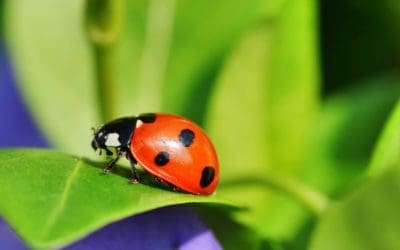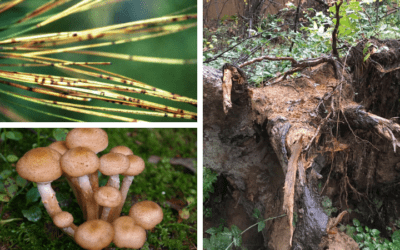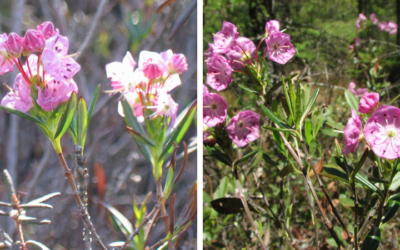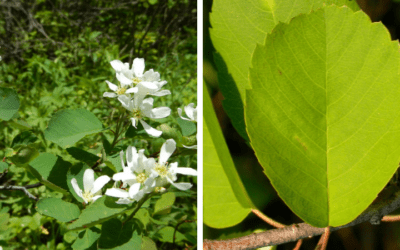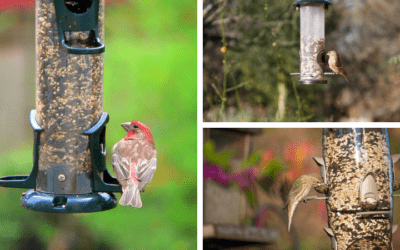Sustainable Holiday Ideas
The season of holiday cheer is here! Read on for some ideas to make your holiday season greener.
Dietary Mushroom Intake Survey
Low consumption of fruits and vegetables coupled with high sodium, saturated fat, and sugar intake contributes to development of chronic diseases, health complications, and death. In fact, a healthy diet would prevent 1 in every 5 deaths in the United States. Although...
Native of the Month: Amethyst Deceiver
Mushrooms never cease to amaze us. Laccaria amethystin, or amethyst deceiver, is no exception. They can be found in broadleaved and coniferous woodlands among the leaf litter in the Pacific Northwest between late summer and autumn. The caps of this striking purple...
The Amazing Network Beneath our Feet
When you think of fungi, you may think of the incredibly diverse fruiting bodies we see above ground, but there is a whole network of fungal threads underneath the forest floor! This network of fungal threads, known as mycelium, intertwine with tree roots...
Dispel the Fear with Spooky Nature Facts!
At SHADOW Lake Nature Preserve, we seek to understand and appreciate the value of all living things and their habitats. In the spooky spirit of this month, we are excited to celebrate some of the more creepy and...
Jumping Spider Responses to Color
Many animals use color to determine whether food is nutritional or poisonous. A ladybug's red color, for example, shows birds that she is toxic to eat. This evolutionary trait is called aposematism. It has been heavily studied that when birds and other animals are...
Native of the Month: Devil’s Club
It's not hard to imagine the origin of this plant's namesake. Devil's club is known for its aggressive spikes on thick yellowish stems. This Pacific Northwest native generally grows around 5 feet tall (1.5 meters), but in undisturbed areas, can reach up to 16 feet (3...
Pacific Northwest Native Tree Diseases
Known as the Evergreen State, Washington is replete with many different species of trees. There are also plenty of diseases that can harm them. The leaves, roots, or branches of various tree species can become infected with diseases that lead to wood decay, reduced...
Effects of Dwarf Mistletoe on Lodgepole Pine Forests
Lodgepole pines grow abundantly throughout North America. Known for its straight, slender, and tall trunks, the lodgepole pine is commonly used to build lodges and cabins. Lodgepole pines are unique because they need fire to reproduce. They have serotinous cones or...
Native of the Month: Bark Beetles
Bark BeetlesBark beetles are both friends and foes. They are native decomposers, pollinators, and food for wildlife in Washington state forests, but they also cause tree mortality which is exacerbated by climate change. Bark beetle species in Washington include red...
SHADOW in the Journal of Biodiversity Data
SHADOW Lake Nature Preserve was featured in the Journal of Biodiversity Data in an article by Will K. Reeves, Jeremy R. Shaw, and Mark Wetzel all thanks to a worm that was found in Shadow Lake Bog. The potworm (Cognettia sphagnetorum) can be found in European...
Native of the Month: Bog Laurel
Bog Laurel - Kalmia MicrophyllaBog laurel, also known as swamp laurel, is a short shrub with oppositely arranged, leathery, glossy leaves. Its stems stand erect, and its small, pink flowers are found in clusters. The fruit are woody capsules that have long stems on...
Carbon Emissions from Wildland Fire Peatlands and Climate Change
Peatlands, like the Shadow Lake Bog, are the most carbon-dense ecosystems on the planet. Peat bogs not only store carbon from thousands of years of decomposing organic matter, but absorb carbon dioxide (CO2), including carbonproduced by human...
Native of the Month: American Pika
American Pika- Ochotona princepsThe American pika lives in high elevation, cool climate areas west of the Rocky Mountains including places like Mount Rainer National Park. Typically found above the tree line, they live on rock faces and cliffs near the...
Significance of Environmental Education
The natural world is a fascinating place that sparks wonder and curiosities in all of us. As human beings, we are a part of the natural world and directly connect to it. But there is a disconnect between our society and the outdoors, and it is predicted to only grow...
Wildfires and the Climate Crisis
Over the past few years, springs and summers in Washington have been replete with wildfires and the consequences have been nothing short of disastrous. By September in 2020, not only did fires burn over 626,982 acres and destroy 181 homes, but the University of...
A Child’s Insight into Biodiversity
Memorable or striking species often receive the most conservation protection. Cute animals like panda bears and brightly colored animals like birds come to mind initially when picturing an ecosystem. Although these mammals, birds, and reptiles are...
Native of the Month: Serviceberry
Serviceberry - Amelanchier alnifolia Western service berry, Saskatoon, or Juneberry is a beautiful woody species that can be spotted throughout most of Canada and western North America because it can grow in a plethora of areas including open forests, stream banks,...
Salmon Increases Bird Abundance
In the Pacific Northwest, we value salmon for a multitude of reasons, but the first that comes to mind may not be that they increase bird abundance and diversity. In a study completed by Marlene Wagner and John Reynolds, they found that more birds habited streams and...
Native of the Month: American Robin
American Robin - Turdus migratoriusAmerican robins can be seen anywhere in North America and are often spotted running through lawns or perched in a tree. In the spring and summer, robin calls are a lovely sound to wake up to in the morning. As larger songbirds,...
Bird Feeders – Dos and Don’ts
Many of us enjoy watching birds in our backyard and love providing food to our feathered friends through bird feeders. However, there is a down side to feeding birds. More than 40% of people in the United States regularly feed birds. Scientific studies have determined...






